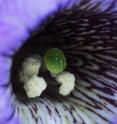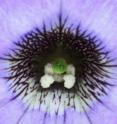To prevent inbreeding, flowering plants have evolved multiple genes, research reveals
A research team led by Teh-hui Kao, professor of biochemistry and molecular biology at Penn State University, in collaboration with a team lead by Professor Seiji Takayama at the Nara Institute of Science and Technology in Japan, has discovered a large suite of genes in the petunia plant that acts to prevent it from breeding with itself or with its close relatives, and to promote breeding with unrelated individuals. In much the same way that human inbreeding sometimes results in genetic disease and inferior health, some inbred plants also experience decreased fitness, and therefore, have developed mechanisms to ensure that their offspring benefit from hybrid vigor -- the mix that results when genetically distinct members of the same species breed. The team's discovery of the multiple inbreeding-prevention genes will be published on 5 November 2010 in the journal Science. The identification of these genes comes on the heels of Kao's earlier identification of two additional inbreeding-prevention genes in the same plant. "Humans have mechanisms to prevent inbreeding that are in part cultural," Kao explained. "But a plant can't just get up and move to the next town to find a suitable, unrelated mate. Some other system must be at work." Kao began to unravel the mystery of what he calls a "non-self recognition system" in the mid 1980s by studying the genetic sequence of petunias. Petunias and many common garden plants are hermaphroditic, possessing both male and female reproductive organs, and these reproductive organs are located in close proximity in the same flower. This floral anatomy makes it easy for a plant's pollen to land on itself, resulting in self-fertilization and genetically inferior, inbred offspring. To prevent self-fertilization, many flowering plants, including the petunia, have evolved a strategy called self-incompatibility, or the ability to recognize self and non-self components within both the male and female reproductive organs.
PRIOR RESEARCH
Because of the petunia's hermaphroditic nature, Kao and his colleagues assumed that there had to be both male and female genetic strategies to prevent a plant from breeding with itself or with close relatives. In 1994, Kao's team discovered the first piece of the self-incompatibility puzzle. In a paper published in Nature, he and his colleagues announced that they had identified a gene called S-RNase (S for self-incompatibility) in Petunia inflata, a wild relative of the garden petunia. The S-RNase gene controls self-incompatibility in the pistil -- the plant's female reproductive organ. Thanks to this gene, the pistil is able to distinguish between self and non-self pollen, which is analogous to sperm cells, and specifically kills self-pollen to prevent inbreeding. Later, in another paper published in Nature in 2004, Kao's team announced the discovery of the male counterpart of S-RNase -- a gene called Type-1 SLF -- that controls self-incompatibility in pollen by distinguishing between self and non-self pistil S-RNase proteins, and specifically detoxifying non-self S-RNase proteins, thereby allowing outcrossing.
That is, the team found that the S-RNase and the Type-1 SLF genes worked in concert to control the way in which the plant accepted or disallowed the introduction of particular pollen into its own reproductive system. In summary, they found that, thanks to the genetic interaction between the male-component and female-component genes, a plant pollinated by its own pollen or by pollen of a similar genotype failed to produce seeds. However, a plant pollinated by pollen of a sufficiently distinct genotype produced seeds and reproduced successfully.
More recently, Kao and his colleagues set out to fill in some important missing pieces in the self-incompatibility puzzle. "During previous research studies, other researchers who had studied the evolutionary histories of Type-1 SLF and S-RNase found no evidence of co-evolution, which was surprising as the male and female genes directly involved in controlling self/non-self recognition during sexual reproduction are expected to have co-evolved." Kao said. "In fact, Type-1 SLF has a much shorter evolutionary history than S-RNase." Meanwhile, Kao and his team noticed that "Type-1 SLF had a much lower allelic sequence diversity when compared to S-RNase, raising a question as to how, with limited allelic diversity, the allelic variants of Type-1 SLF proteins can recognize a large repertoire of 40 or more highly divergent S-RNase proteins," he said. "We were puzzled by how the Type-1 SLF gene seemed to have such a young evolutionary history, and how the allelic variants of Type-1 SLF protein seemed to have such a low sequence diversity. We knew that the male and female genetic counterparts had to have kept up with each other throughout evolution -- they had to have co-evolved -- so that meant there had to be older and more numerous SLF genes controlling the male side of the equation."
NEW DISCOVERIES
Now, in the soon-to-be-published Science paper, the team will announce its identification of five additional types of SLF genes -- named Type-2 to Type-6 SLF genes -- found in the same chromosomal region as the Type-1 SLF gene. Kao and his colleagues found that while the Type-1 SLF gene certainly played an important role in preventing inbreeding, Type-2 and Type-3, and most likely additional types of SLF genes, also controlled self-incompatibility. "Each Type-1 SLF protein can recognize only a limited number of non-self S-RNase components," Kao said. "Meanwhile, each of the additional types of SLF proteins we've found can recognize different sets of non-self S-RNase proteins, and all of them collectively account for the entire suite of non-self identification. This recent finding has solved the puzzle about the co-evolution between the male and female genes, and how a single type of SLF protein has the capacity to recognize a large number of highly divergent S-RNase proteins."
Kao also explained that self-incompatibility in plants can be likened to the adaptive immune system in vertebrates. "The plant needs to distinguish between non-self and self to know which plants it should breed with and which it should reject as too similar," Kao explained. "In the same way, our bodies distinguish between non-self and self to know what to attack and what to leave alone." Kao explained that when pathogens enter our bodies, our T-cells recognize them as foreign invaders and battle against them by triggering production of antibodies by B-cells. "When this system goes awry, our bodies misidentify self as non-self and attack it," Kao said. "These attacks on our own tissues are known as auto-immune disorders; arthritis and Lupus are just a couple of examples." Kao also explained that, just as we have evolved many different types of T-cell receptors to collectively recognize the many foreign antigens we might encounter in our environment, plants have evolved many versions of self-incompatibility genes that produce multiple types of SLF proteins in pollen to collectively recognize a large suite of possible non-self elements -- S-RNase proteins.
In addition to Kao, other members of the research team include Ken-ichi Kubo, Tetsuyuki Entani, Akie Takara, Mamiko Toyoda, Shin-ichi Kawashima, Akira Isogai, and Seiji Takayama from Japan's Nara Institute of Science and Technology; Ning Wang, Allison M. Fields, and Zhihua Hua from Penn State; and Toshio Ando from Japan's Chiba University. The research conducted at Penn State was funded by the National Science Foundation.
Source: Penn State
Other sources
- To prevent inbreeding, flowering plants have evolved multiple genes, research revealsfrom Science DailySat, 6 Nov 2010, 3:40:28 UTC
- To prevent inbreeding, flowering plants have evolved multiple genes, research revealsfrom PhysorgThu, 4 Nov 2010, 18:20:37 UTC


